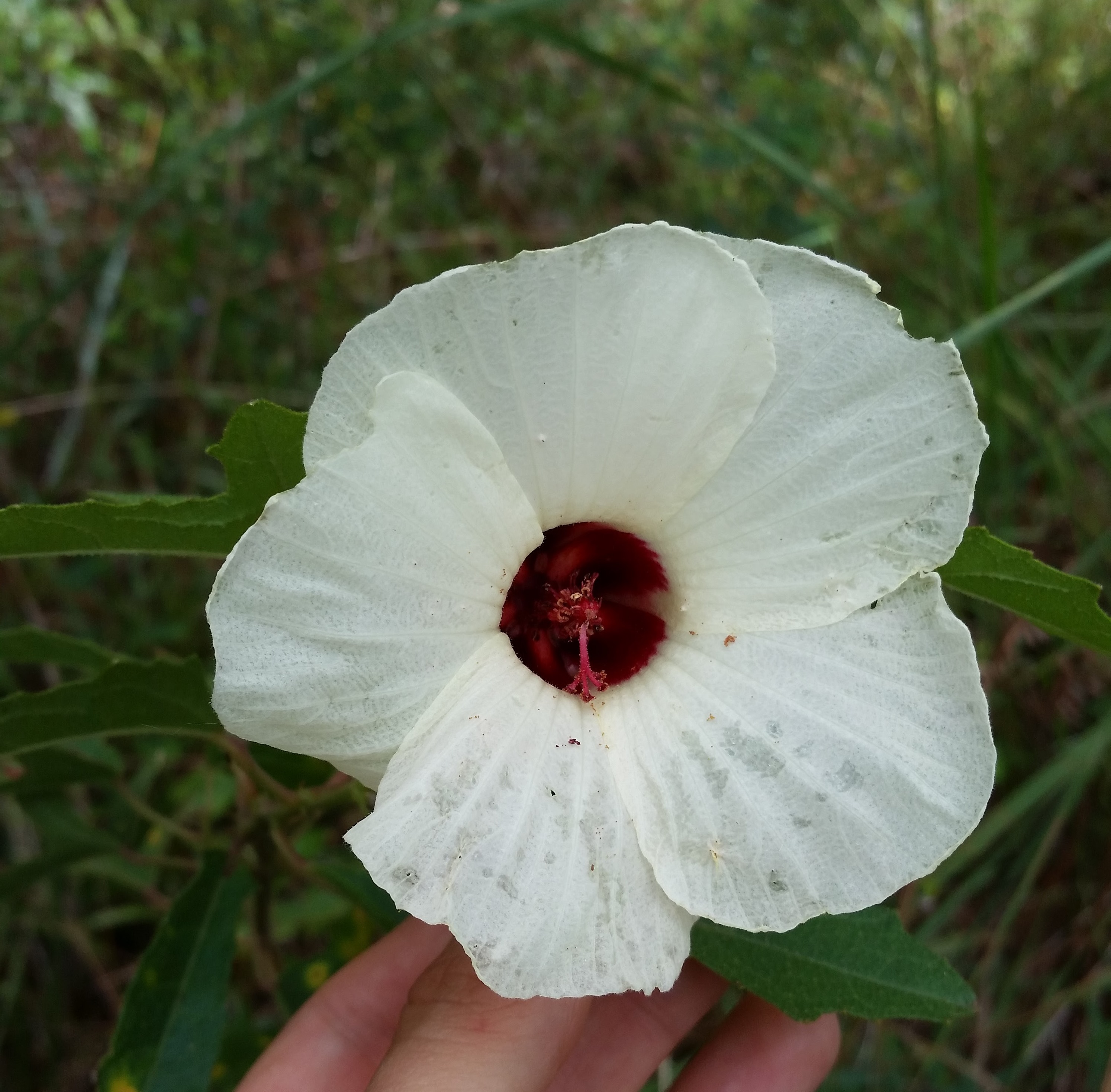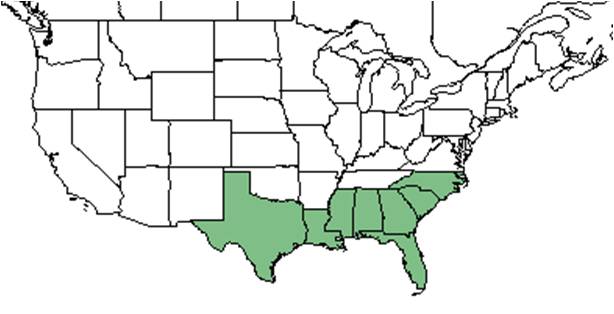Hibiscus aculeatus
Common name: comfort-root; savanna Hibiscus
| Hibiscus aculeatus | |
|---|---|

| |
| Hibiscus aculeatus | |
| Scientific classification | |
| Kingdom: | Plantae |
| Division: | Magnoliophyta - Flowering plants |
| Class: | Dicots |
| Order: | Malvales |
| Family: | Malvaceae |
| Genus: | Hibiscus |
| Species: | H. aculeatus |
| Binomial name | |
| Hibiscus aculeatus Walter | |

| |
| Natural range of Hibiscus aculeatus from USDA NRCS Plants Database. | |
Contents
Taxonomic notes
Synonym: none.[1]
Varieties: none[1]
Description
"Shrubs or perennial or annual herbs with stellate pubescence. Leaves unlobed to palmately lobed or dissected; petioles usually long; stipules present, usually caduceus flowers solitary in the upper leaf axils, or in terminal racemes; peduncles and pedicels present or the peduncle obsolete, often elongating in fruit. Involucral bracts 7-15, linear. Sepals 5, widely triangular to triangular-lanceolate, enlarged in fruit; petals oblanceolate to obovate, apex rounded; stamens usually numerous; stigmas 5, capitate, styles free near apex. Capsule 5-locular." [2]
"Perennial with spreading-ascending or, less frequently erect branches to 1m tall. Trichomes of stems, petioles, leaves and pedicels short, bristly, stellate, scabrous. Leaves palmately 3-5 cleft or lobed, 3-9 cm long, mostly wider than long, coarsely and irregularly serrate, truncate to cleft with an inverted broad, V-shaped sinus; petioles 2-10 cm long. Flowers in leafly-bracteate racemes, bracts less divided than the leaves or entire; peduncles obsolete or to 2 mm long; pedicels 5-12 mm long, elongated slightly in fruit, usually with a few long white trichomes; Involucral bracts 8-10, linear, 1-2 cm long, usually palmately or pinnately cleft at apex. Calyx lobes triangular-lanceolate, 8-12 mm long, acute, elongated in fruit, distinctly keeled to the apex and with a thickened margin resembling the keel, pubescent with long stiff, postulate-based trichomes; petals cream, turning a deeper yellow and finally fading to pink, crimson marked at base, 5-6 cm long. Capsule gradually contracted to a beak, 1.7-2 cm long, pubescent with mixed short and long, bristle-like trichomes. Seeds brown, with fine reticulations and with a few whitish papillate, 3.5-4 mm long." [2]
Distribution
Hibiscus aculeatus is found along the southeastern coastal plain, from North Carolina south to Florida and west to Texas.[3] Within this distribution, it is found from southeastern North Carolina south to south central peninsular Florida and west to Louisiana and Texas.[1]
Ecology
Habitat
Generally, Hibiscus aculeatus can be found in pine savannas and dry loamy or sandy soils found in maritime forests.[1] Otherwise it is found in plains, prairies, pastures, meadows, and woodland openings or edges. It prefers full sun or partial shade, soil that is slightly acidic, and can withstand winter flooding.[4] Also, it has been observed in a variety of habitats including open canopy of pine-wood woodlands, roadbanks and roadsides, ditches, pond and stream margins, flatwoods, sandhills, riverbanks, swales, open and hillside bogs, various low lying areas, and other disturbed areas. Soils include sandy peat, moist and dry loamy sand, calcareous soil, moist sandy loam, and other similar sandy soils.[5] It is listed by the USDA Natural Resources Conservation Service as a facultative wetland species, where it most often can be found in wetland habitats but can also occasionally occur in non-wetland habitats.[3] One study found H. aculeatus to be more affected by clearcutting the overstory rather than thinning the overstory.[6] As well, it is considered an indicator species of the north Florida upper panhandle savannas.[7]
Associated species includes Buchnera floridana, Hypericum opacum, Eryngium integrifolium, Xyris elliottii, Habenaria integra, Polygala ramosa, Polygala lutea, Ctenium aromaticum, Hibiscus aculeatus, and others.[5]
Hibiscus aculeatus is an indicator species for the Upper Panhandle Savannas community type as described in Carr et al. (2010).[8]
Phenology
H. aculeatus generally flowers from June until August, and fruits from July until September.[1] It has been observed to flower May to September with peak inflorescence in July.[9]
Fire ecology
It is a component of ecosystems that are fire-dependent.[7] A study by Kush found H. aculeatus to benefit most from summer burn regiments rather than winter or spring burn regiments.[10]
Pollination
Bumble bees have been observed to visit and pollinate this species.[11] More specifically, this species has been observed to host bees such as Ptilothrix bombiformis (family Apidae).[12]
Conservation, cultivation, and restoration
It is listed as G4 on the global scale due to its distribution and the fact that it is considered critically imperiled in North Carolina.[13]
For easy maintenance, this plant can be cut to the base after a frost for successful resprouting.[4]
Cultural use
The roots have been used as a soothing agent leading to the name "comfortroot".[14][15][16][17]
Photo Gallery
References and notes
- ↑ 1.0 1.1 1.2 1.3 1.4 Weakley, A.S. 2020. Flora of the Southeastern United States. Edition of 20 October 2020. University of North Carolina at Chapel Hill, Chapel Hill, North Carolina.
- ↑ 2.0 2.1 Radford, Albert E., Harry E. Ahles, and C. Ritchie Bell. Manual of the Vascular Flora of the Carolinas. 1964, 1968. The University of North Carolina Press. 704-6. Print.
- ↑ 3.0 3.1 USDA, NRCS. (2016). The PLANTS Database (http://plants.usda.gov, 22 May 2019). National Plant Data Team, Greensboro, NC 27401-4901 USA.
- ↑ 4.0 4.1 [[1]] Lady Bird Johnson Wildflower Center. Accessed: May 22, 2019
- ↑ 5.0 5.1 Florida State University Robert K. Godfrey Herbarium database. URL: http://herbarium.bio.fsu.edu. Last accessed: May 2019. Collectors: Loran C. Anderson, A. H. Curtiss, J. P. Gillespie, Robert K. Godfrey, Bruce Hansen, C. Jackson, Darren Jackson, Ed Keppner, Lisa Keppner, Gary R. Knight, R. Komarek, Robert Kral, S. W. Leonard, Karen MacClendon, Travis MacClendon, Sidney McDaniel, M. Y. Menzel, Richard S. Mitchell, T. Myint, Leon Neel, R. A. Norris, Kevin Oakes, Gwynn W. Ramsey, P. L. Redfearn, Jr., D. B. Ward, and F. D. Wilson. States and Counties: Alabama: Conecuh. Florida: Bay, Calhoun, Escambia, Franklin, Holmes, Jackson, Lafayette, Leon, Madison, Nassau, Okaloosa, Santa Rosa, Taylor, and Wakulla. Georgia: Grady and Thomas.
- ↑ Brockway, D. G. and C. E. Lewis (2003). "Influence of deer, cattle grazing and timber harvest on plant species diversity in a longleaf pine bluestem ecosystem." Forest Ecology and Management 175: 49-69.
- ↑ 7.0 7.1 Carr, S. C., et al. (2010). "A Vegetation Classification of Fire-Dependent Pinelands of Florida." Castanea 75(2): 153-189.
- ↑ Carr, S.C., K.M. Robertson, and R.K. Peet. 2010. A vegetation classification of fire-dependent pinelands of Florida. Castanea 75:153-189.
- ↑ Nelson, G. PanFlora: Plant data for the eastern United States with emphasis on the Southeastern Coastal Plains, Florida, and the Florida Panhandle. www.gilnelson.com/PanFlora/ Accessed: 12 DEC 2016
- ↑ Kush, J. S., et al. (2000). Understory plant community response to season of burn in natural longleaf pine forests. Proceedings 21st Tall Timbers Fire Ecology Conference. Fire and forest ecology: innovative silviculture & vegetation management, Tallahassee, FL, Tall Timbers Research, Inc.
- ↑ Pitts-Singer, T. L., et al. (2002). "Insect pollinators of three rare plants in a Florida longleaf pine forest." Florida Entomologist 85(2): 308-316.
- ↑ Discoverlife.org [2]
- ↑ [[3]] NatureServe Explorer. Accessed: May 22, 2019
- ↑ Denhof, Carol. 2017. Plant Spotlight Hibiscus Aculeatus Comfortroot. The Longleaf Leader - Public Lands Restoration. Vol. X. Iss. 2. Page 6
- ↑ Miller, J.H. and K.V. Miller. Forest Plants of the Southeast and their Wildlife Uses. The University of Georgia Press, Atehns, GA. 454pp.
- ↑ Xerces Society. 2011. Attracting Native Pollinators-Protecting North America's Bees and Butterflies. Story Publishing, North Adams, MA.
- ↑ USDA, NRCS. 2017 The PLANTS Database (http://plants.usda.gov, 21 April 2017). National Plant Data Team, Greensboro, NC 27401-4901 USA.